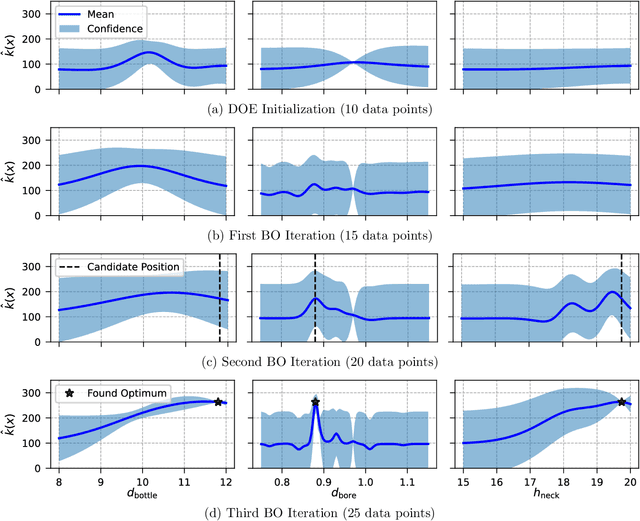Andreas Wimmer
Finding the Optimum Design of Large Gas Engines Prechambers Using CFD and Bayesian Optimization
Aug 03, 2023



Abstract:The turbulent jet ignition concept using prechambers is a promising solution to achieve stable combustion at lean conditions in large gas engines, leading to high efficiency at low emission levels. Due to the wide range of design and operating parameters for large gas engine prechambers, the preferred method for evaluating different designs is computational fluid dynamics (CFD), as testing in test bed measurement campaigns is time-consuming and expensive. However, the significant computational time required for detailed CFD simulations due to the complexity of solving the underlying physics also limits its applicability. In optimization settings similar to the present case, i.e., where the evaluation of the objective function(s) is computationally costly, Bayesian optimization has largely replaced classical design-of-experiment. Thus, the present study deals with the computationally efficient Bayesian optimization of large gas engine prechambers design using CFD simulation. Reynolds-averaged-Navier-Stokes simulations are used to determine the target values as a function of the selected prechamber design parameters. The results indicate that the chosen strategy is effective to find a prechamber design that achieves the desired target values.
Are Quantitative Features of Lung Nodules Reproducible at Different CT Acquisition and Reconstruction Parameters?
Aug 14, 2019



Abstract:Consistency and duplicability in Computed Tomography (CT) output is essential to quantitative imaging for lung cancer detection and monitoring. This study of CT-detected lung nodules investigated the reproducibility of volume-, density-, and texture-based features (outcome variables) over routine ranges of radiation-dose, reconstruction kernel, and slice thickness. CT raw data of 23 nodules were reconstructed using 320 acquisition/reconstruction conditions (combinations of 4 doses, 10 kernels, and 8 thicknesses). Scans at 12.5%, 25%, and 50% of protocol dose were simulated; reduced-dose and full-dose data were reconstructed using conventional filtered back-projection and iterative-reconstruction kernels at a range of thicknesses (0.6-5.0 mm). Full-dose/B50f kernel reconstructions underwent expert segmentation for reference Region-Of-Interest (ROI) and nodule volume per thickness; each ROI was applied to 40 corresponding images (combinations of 4 doses and 10 kernels). Typical texture analysis metrics (including 5 histogram features, 13 Gray Level Co-occurrence Matrix, 5 Run Length Matrix, 2 Neighboring Gray-Level Dependence Matrix, and 2 Neighborhood Gray-Tone Difference Matrix) were computed per ROI. Reconstruction conditions resulting in no significant change in volume, density, or texture metrics were identified as "compatible pairs" for a given outcome variable. Our results indicate that as thickness increases, volumetric reproducibility decreases, while reproducibility of histogram- and texture-based features across different acquisition and reconstruction parameters improves. In order to achieve concomitant reproducibility of volumetric and radiomic results across studies, balanced standardization of the imaging acquisition parameters is required.
Detection and Visualization of Endoleaks in CT Data for Monitoring of Thoracic and Abdominal Aortic Aneurysm Stents
Feb 09, 2016Abstract:In this paper we present an efficient algorithm for the segmentation of the inner and outer boundary of thoratic and abdominal aortic aneurysms (TAA & AAA) in computed tomography angiography (CTA) acquisitions. The aneurysm segmentation includes two steps: first, the inner boundary is segmented based on a grey level model with two thresholds; then, an adapted active contour model approach is applied to the more complicated outer boundary segmentation, with its initialization based on the available inner boundary segmentation. An opacity image, which aims at enhancing important features while reducing spurious structures, is calculated from the CTA images and employed to guide the deformation of the model. In addition, the active contour model is extended by a constraint force that prevents intersections of the inner and outer boundary and keeps the outer boundary at a distance, given by the thrombus thickness, to the inner boundary. Based upon the segmentation results, we can measure the aneurysm size at each centerline point on the centerline orthogonal multiplanar reformatting (MPR) plane. Furthermore, a 3D TAA or AAA model is reconstructed from the set of segmented contours, and the presence of endoleaks is detected and highlighted. The implemented method has been evaluated on nine clinical CTA data sets with variations in anatomy and location of the pathology and has shown promising results.
 Add to Chrome
Add to Chrome Add to Firefox
Add to Firefox Add to Edge
Add to Edge